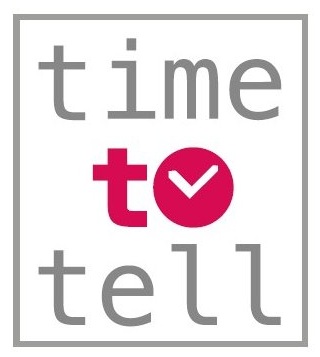9 April 2024
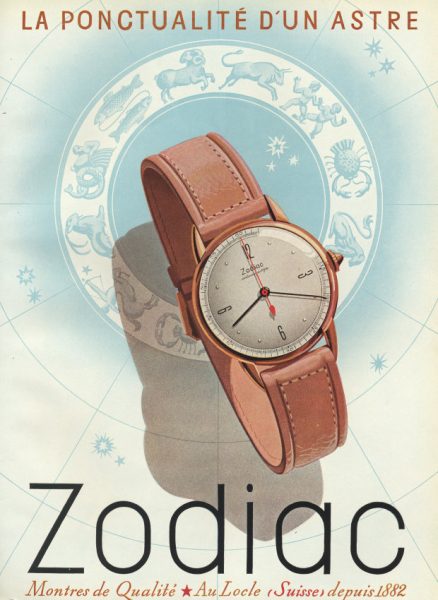
By Joël Pynson
Zodiac Watch Co. is one of those Swiss watchmaking companies that have changed hands several times and whose history is difficult to trace.
Zodiac still exists, but the history available on the current company’s website is rather fanciful1 .
Most of the information currently available on the Internet seems to come from an article in The Swiss Watch magazine from 1957, written for the company’s 75th anniversary2 . This is the case, for example, on Wikipedia3 , or on several American sites4 as the article was also written in English.
But the article contains many errors and omissions. It is therefore necessary to delve into the watchmaking archives to try and piece together the story of Zodiac and the Calame family from Le Locle.
1. The Calame dynasty
Ariste Calame senior set up a small workshop in Le Locle in 1882. He assembled watches for other manufacturers, such as Favre Perret5 .
His son, also named Ariste, joined him in 1895. He was an excellent watchmaker: trained at the Le Locle watchmaking school and a pupil of Jules Grossmann6 . He was not afraid of complicated watches, and patented a repeater system in 18987 .
In 1899, the company moved to rue du Marais, and a year later Ariste Fils took over its management. The business grew: in 1901 the Zodiac trademark was registered, and in 1908 the first Zodiac factory in Le Locle was built on rue Bellevue. At the time, the factory employed around twenty workers.
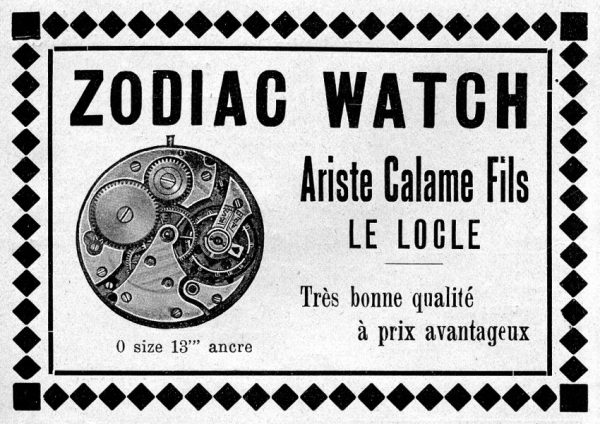
1915
Ariste junior made an important decision around 1915: from now on, the company would manufacture its own ébauches8 . At that time, production was running at 100 watches a day, pocket watches of course, but also wristwatches, models of which were registered in 1915.
In 1922, Ariste’s son René, trained at the Technicum in Le Locle, joined the company. From then on, the company produced “neat” anchor watches with 8 to 19 lines, in gold and silver, which were increasingly exported to Japan, where unsigned watches were purchased. At the time, Japan was the 4th market for Swiss watches, behind the United States, Germany and Great Britain9 .
In 1928, the company changed its name to Manufacture d’Horlogerie Zodiac10 .
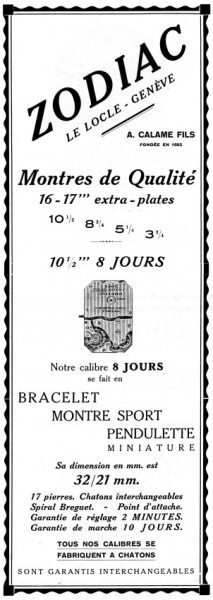
1930
1930 was a paradoxical year for Zodiac. In addition to its magnificent ultra-slim 16-line caliber, it released a remarkable rectangular 8-day caliber measuring just 32 x 21 mm, developed in conjunction with Manufacture Angélus, also based in Le Locle. Ariste junior had married Mathilde Stolz, sister of the Stolz brothers who founded Manufacture Angélus. But 1930 also saw the start of the severe economic crisis that was to hit the watchmaking industry, with disastrous consequences for Zodiac: Japan closed its doors to imports.
The Calame family was reduced to selling their watches themselves11 : “We had to start practically from scratch. The manufacture of ébauches was abandoned, and the workshop sold. My father and I, with our collection under our arm, set off to sell watches to watchmakers in Switzerland and France. But a decision was taken that would prove salutary: the introduction of a brand policy: all watches would henceforth be called Zodiac. In 1933, the company became Zodiac SA.
In 1934 Ariste Calame Junior became vice-president of the Association des Fabricants d’Horlogerie du district du Locle.
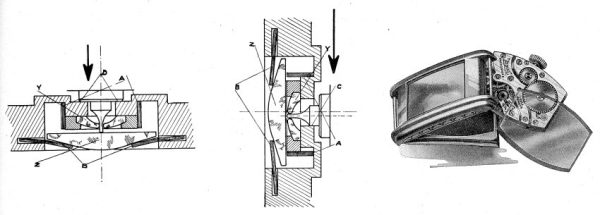
1934
When all companies are suffering, you sometimes have to be opportunistic. Fabrique Election was in dire straits, and Zodiac bought out its patents for an anti-shock system. In 1929, Les Fils de L. Braunschweig, Fabrique Election in La Chaux-de-Fonds, had patented12 a system protecting against both axial and lateral shocks.
This was probably the first anti-shock system to be industrialized, since it was fitted on Election watches as early as 193013 . Zodiac used it as a selling point in 1934, calling its watches “unbreakable”. This rather optimistic appellation was replaced in 1937 by “Incasécurit“.
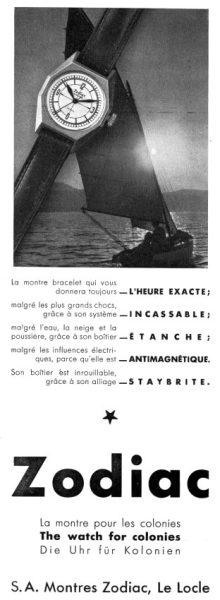
1936
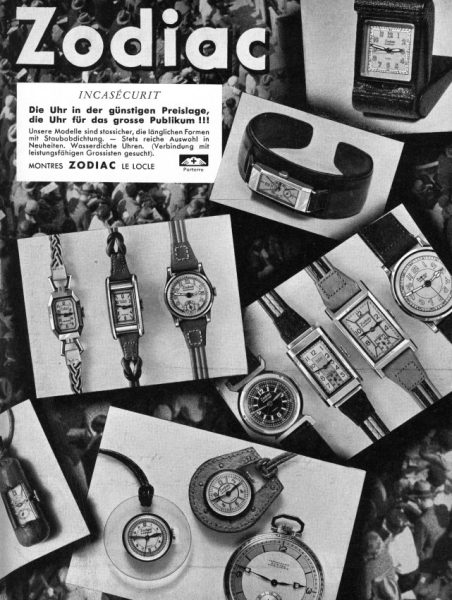
1937
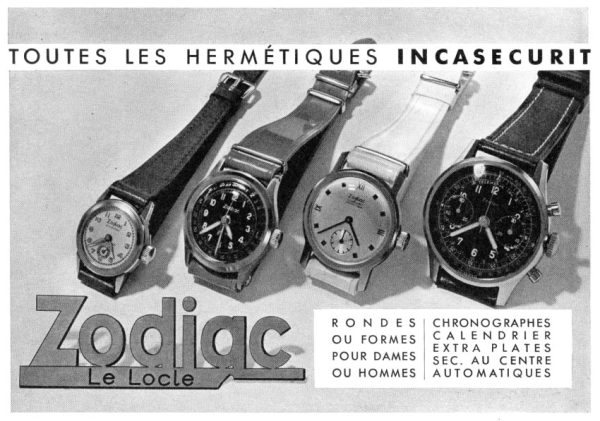
1941
From 1935 onwards, business picked up steadily, and the Second World War did nothing to halt the company’s progress: 1936 saw the first water-resistant watches, which would later give the company undeniable experience; 1940 saw the first chronographs, the first automatic watches; 1941 saw the first calendar watches, the first chronometers and the first water-resistant chronographs.
In 1943 Zodiac claimed to be the official supplier to the Swiss Post Office and the Swiss Railways14 .
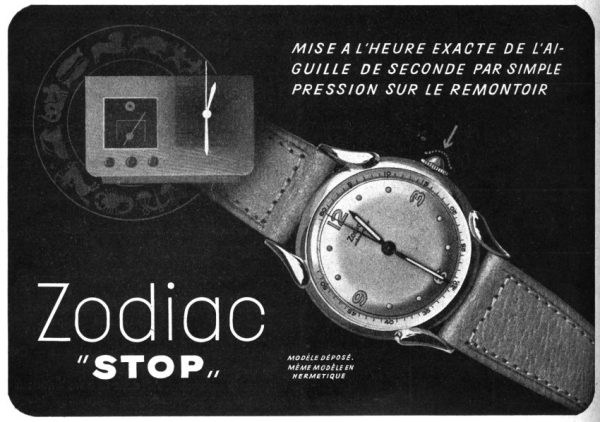
1945
In 1945, Zodiac introduced a stop-seconds system that would be used regularly thereafter: by simply pressing the winding crown, the seconds hand is blocked, enabling precise time-setting15 .
1945 was also the year in which Maurice Calame, René’s brother, joined the company16 . In charge of sales, he quickly developed an efficient network of distributors around the world, particularly in the United States. Marketing was modernized with international advertising campaigns.
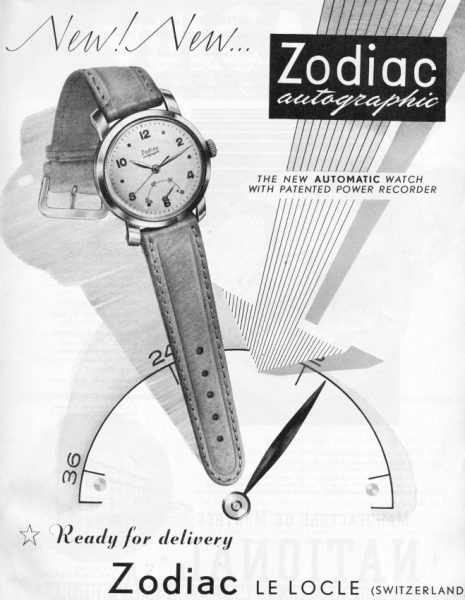
1949
In 1948, Zodiac caused a sensation by presenting the Autographic, the first automatic watch with power reserve, whose patents17 were registered in association with Manufacture LeCoultre of Le Sentier. It may seem surprising that a watchmaker, obliged by the “statut horloger” to buy from Ébauches SA, should be able to innovate in this way, even in association with a Manufacture. René Calame explains a few years later: “We have considerable latitude thanks to our close collaboration with Ébauches SA. Sometimes we make our own designs and ask Ébauches to manufacture calibers for which we have patents. Our caliber with power reserve indicator is an excellent example of this collaboration18 .”
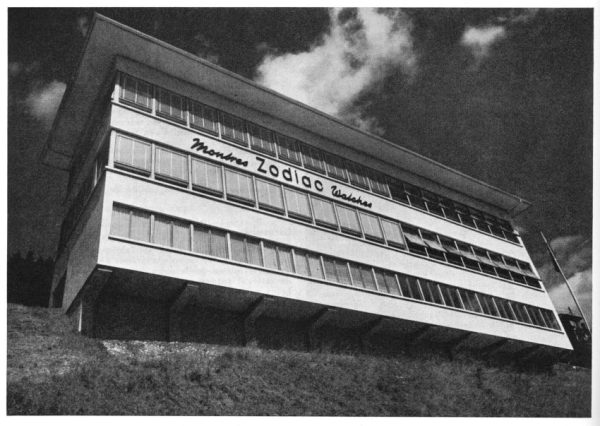
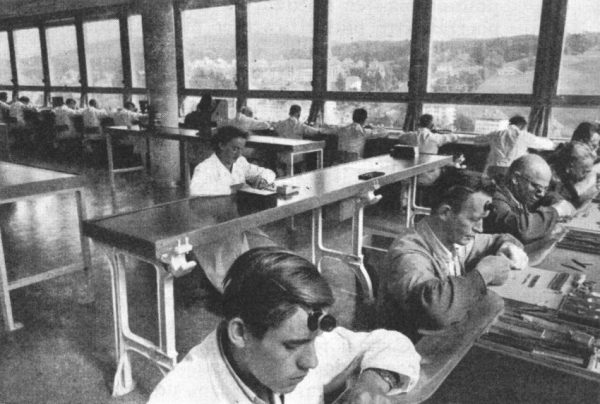
New plant and workshops in 1951
1951 was a banner year for Zodiac, which inaugurated a new, ultra-modern factory built into the hillside above the Le Locle train station19
The elegant building, designed by architect Paul Davoine, cantilevers slightly over the slope, giving it a very airy appearance. Inside, vast workshops with large bay windows house ergonomic workstations featuring the latest technical advances.
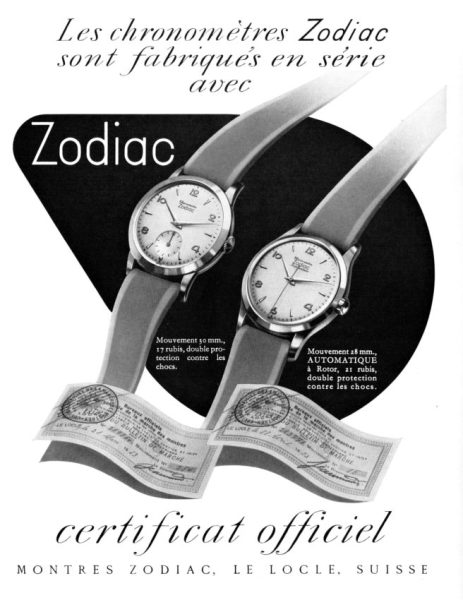
1954
In 1952, Zodiac launched two new models: the Captain and the Glorious. The Captain had a relatively short life, probably because the Captain trademark had already been registered by Zenith in 194520 . It was also in the early 1950s that Zodiac began mass-producing chronometers, which were tested in official control offices.
In 1953, Ariste Calame, who could be proud of his achievements, retired from the company. He died two years later.
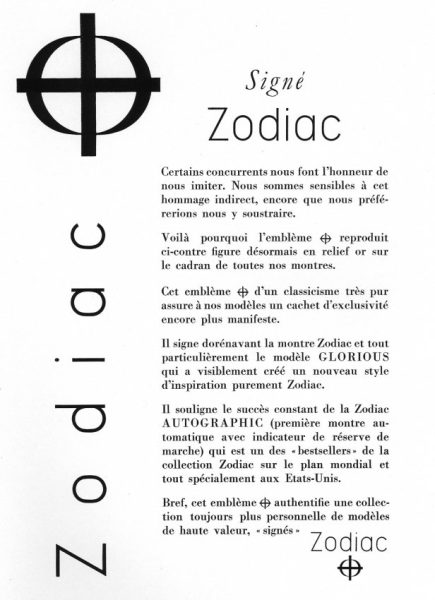
1954
In 1954, Zodiac decided to apply a new emblem to the dial of its watches: a circled cross applied in relief. This decision seems to have been taken to combat the numerous counterfeits of the Zodiac brand appearing in the world21 . By 1957, production was running at 80,000 watches a year. The following year, Zodiac presented one of its most emblematic models at the Basel Fair: the Sea Wolf diver’s watch.
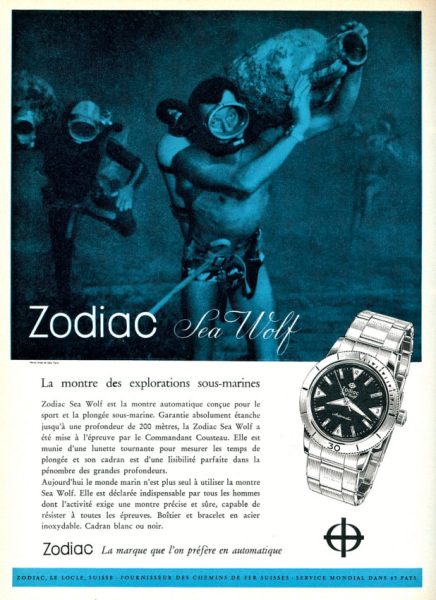
1959
In 1958, under the impetus of René Calame, the CHP (Communauté d’Horlogerie de Précision) was created. The CHP brought together 9 independent watchmakers who decided to pool their efforts in the manufacture and technical improvement of watches. They were Doxa, Ernest Borel, Ebel, Eberhard & Co, Favre-Leuba, Girard- Perregaux, Heuer, Juvénia and Zodiac22 .
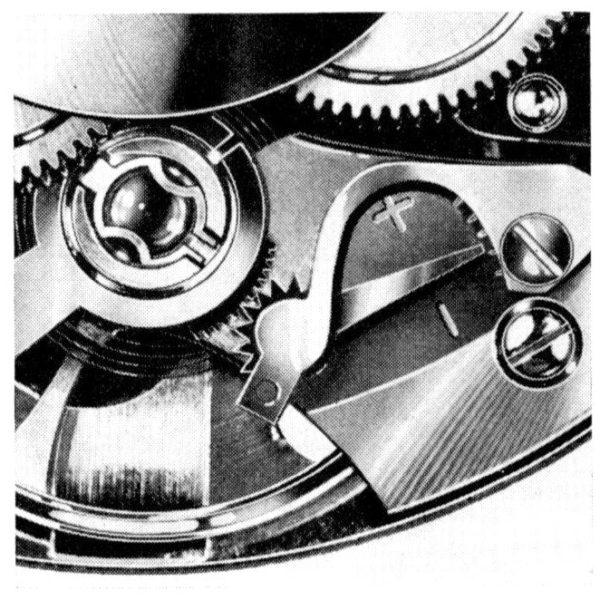
This racket fine-tuning system was developed for CHP members.
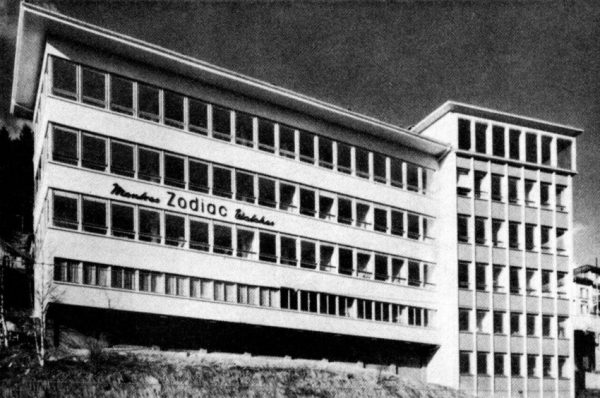
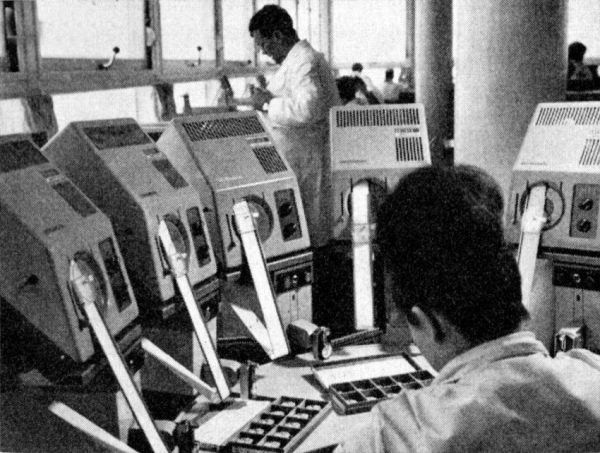
Factory extension in 1964
In 1961, René’s son Pierre joined the company. It was around this time that Zodiac launched a handful of “electric” watches. These were watches equipped with the Landeron 4750 electric caliber, a movement with a spiral balance maintained by an intermittent electromagnetic field, as used by Hamilton and Lip.
In 1964, the Le Locle factory was enlarged. Technically, the oscillation frequency of mechanical calibers increased from 18,000 to 21,600 A/h, reinforcing the production of chronometers in series23 . The increase in oscillation frequency continued in 1967, thanks to CHP’s involvement in the development of 36,000 vph calibers24 .
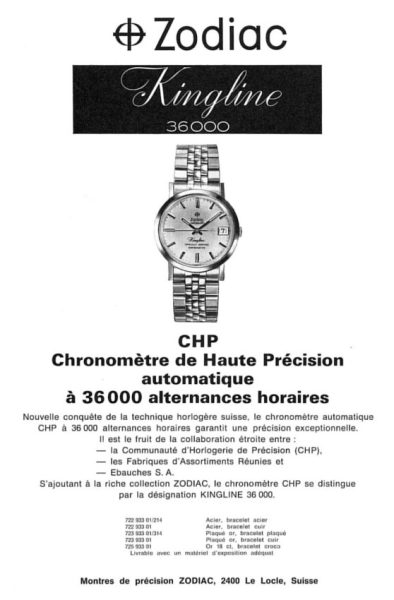
1967

1968
In 1967, Zodiac launched its “Kingline 36,000” range, later renamed “SST 36,000” (for Split Second Timing). But Zodiac was also interested in electronics, and that same year launched its “Spacetronic” electronic pendulum watch. Unfortunately, the Spacetronic was a failure: the Dynotron caliber was supplied by Ébauches SA to a number of companies who undercut the price, and Zodiac had to sell off its electronic watches25 .
Zodiac was one of the very first Swiss companies to offer a quartz watch as early as 1970, thanks to the adoption of the beta 21 caliber developed by CEH (Centre Electronique Horloger) and marketed by several other manufacturers such as Universal, Ebel, Jaeger- LeCoultre and others. It was also in 1970 that Zodiac introduced the Astrographic model, with its highly avant-garde design.
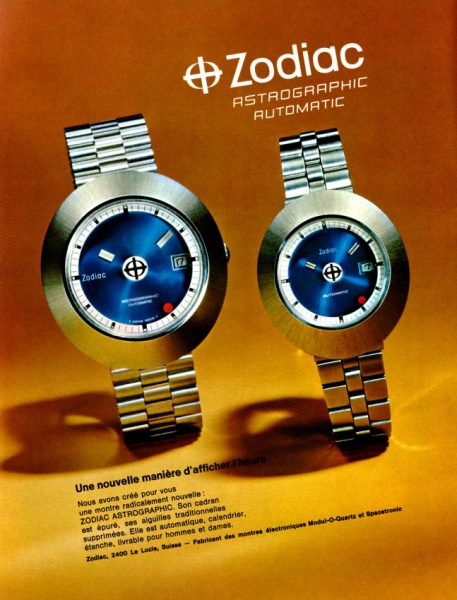
1971
In Switzerland, this period saw the creation of numerous groupings of watchmaking companies, to strengthen their position in the face of foreign competition. Examples include Manufactures d’Horlogerie Suisses Réunies (MSR), which brings together Buser, Phenix, Revue and Vulcain, and the impressive General Watch Holding, which includes Certina, Edox, Era, Eterna, Mido, Oris, Rado and Technos.
Zodiac was of course approached, but the desire for independence was fierce: “A company like Zodiac has a lot to offer in terms of relationships, experience and reputation, and can only agree to sacrifice part of its freedom in exchange for such concrete contributions, both technical and commercial26 .” It must also be said that the company was doing well: in 1971, it produced 200,000 watches and had 150 employees. Its market distribution was as follows: USA 35%, Europe 30%, Asia 20%27 .
In 1972, Pierre Calame takes over the management of Zodiac. The share of the U.S. market grew rapidly, leaving the company highly exposed: in 1973, 40% of sales were made in the USA, rising to 50% in 1975. But this market was in upheaval with the arrival of inexpensive quartz watches, sold not by watchmakers but by electronics manufacturers such as Texas Instrument and National Semiconductor. What’s more, the dollar is collapsing, losing 33% against the Swiss franc28 .
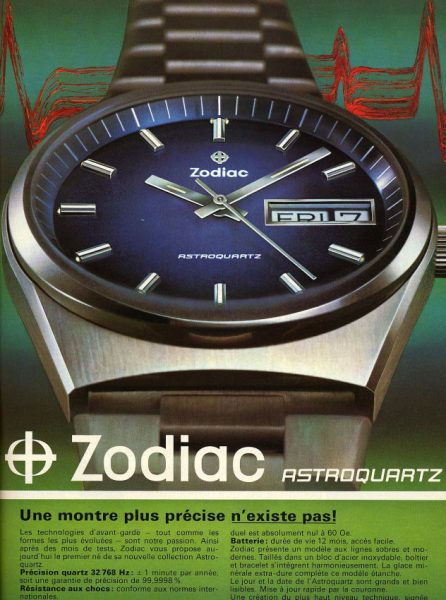
1974
In 1975, Zodiac integrated Horelec with SGT, Aetos, Camy, Enzo, Ogival, Kelek, Eska, Catena and Gramex29 . The aim was to produce an affordable Swiss quartz caliber. Pierre Calame is lucid: “The main handicaps that make it difficult to sell Swiss watches are often mentioned: a general economic crisis and the cost of the Swiss franc, which is far too high. The reason which is often overlooked, however, and which must be mentioned, is: a considerable technological backwardness30 .”
In 1976, while Zodiac was presenting the first LCD quartz chronometers at the Basel Fair31 (with Wittnauer and Yves Saint Blaise), the Zodiac distributor in the United States went bankrupt32 . The blow was too great for Zodiac, which desperately tried to reconvert to luxury watches, but was bought out by Dixi in 197833 . It was the end of the Calame dynasty. The brand was gradually mothballed.
———————-
Dixi, well known as a manufacturer of machines for the watchmaking industry, was in fact a highly diversified group with interests in compressors, measuring instruments, armaments, furniture and even watchmaking, thanks to the takeover of the Paul Buhré company in 1963. In the 1970s, Dixi’s watchmaking pole became impressive, with the buyout/save out of no fewer than 6 companies, most of them based in Locle: Robert Cart, Henry Moser & Cie, Jean Perret, Luxor, Zénith-Movado and Zodiac.
———————-
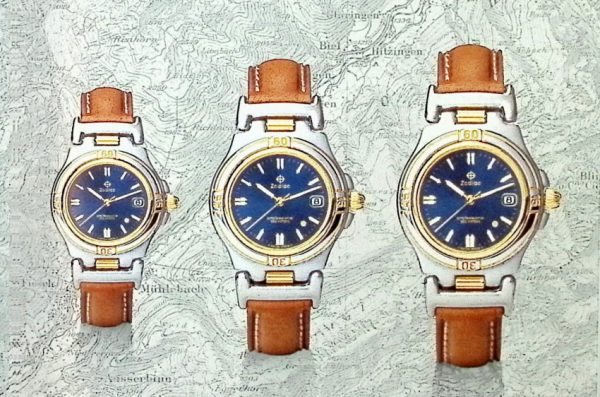
1991
In 1989 the brand was acquired from Dixi by Willy Monnier, former CEO of Heuer. Paul Castella, who heads Dixi, remains on the board, and the watches are to be manufactured by Zenith, one of Dixi’s companies34 . The watches are classic, “chic and sporty”, but strongly inspired by competing designs. The results did not live up to expectations: in 1997, Montres Zodiac SA went bankrupt35 . The brand was mothballed once again.
In 2002, the American company Fossil Inc. bought and relaunched the Zodiac brand, which is still active today.
1. Landmark models
In the 1950s, Zodiac set itself apart from its competitors by creating original models with distinctive designs, some of which are still sought after by collectors today.
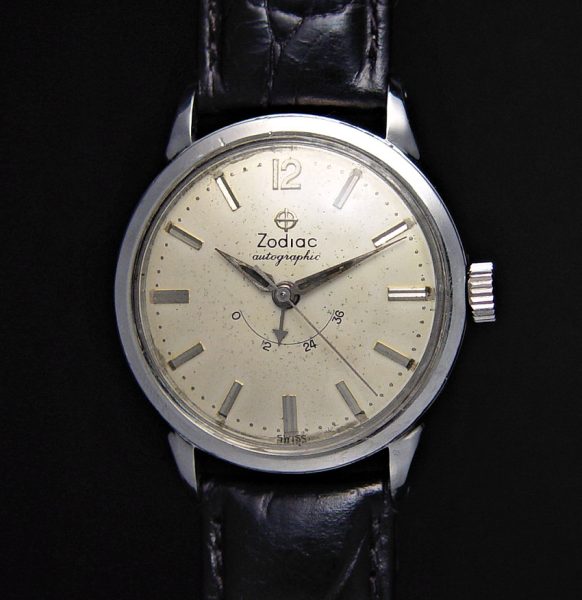
The Autographic model of 1949 certainly stood out for its power reserve at 6 o’clock36 , but the design of the case and hands was very classic.
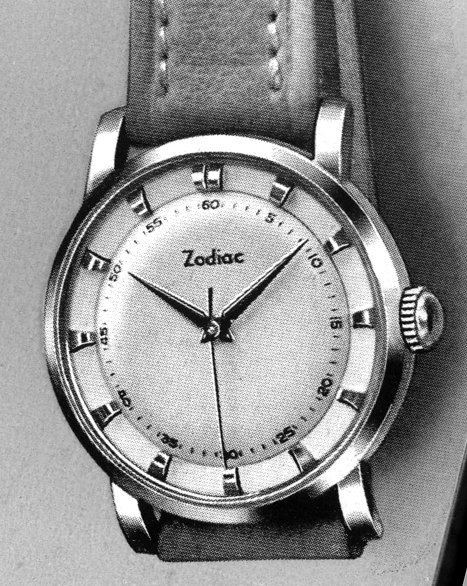
Zodiac Captain
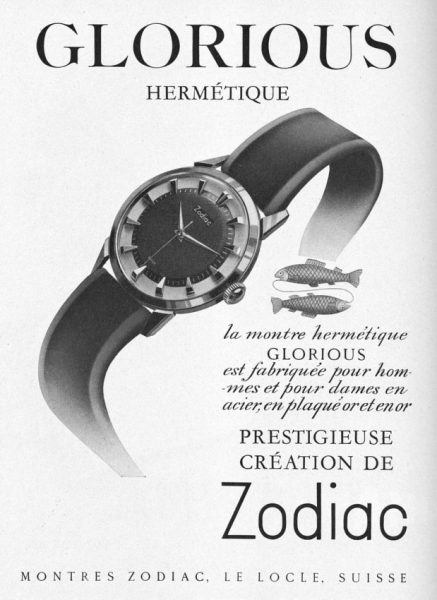
1953
In 1952, Zodiac inaugurated a series of creations under the banner “A new face for watches37 “. First came the Captain model, with a domed central dial and a flat enamel periphery with high-relief hour-markers. But it’s above all the Glorious model, with its large, raised indexes on the periphery that give the dial a 3-dimensional appearance. An Autographic version of the Glorious was released in 1955, and a date version in 1956.
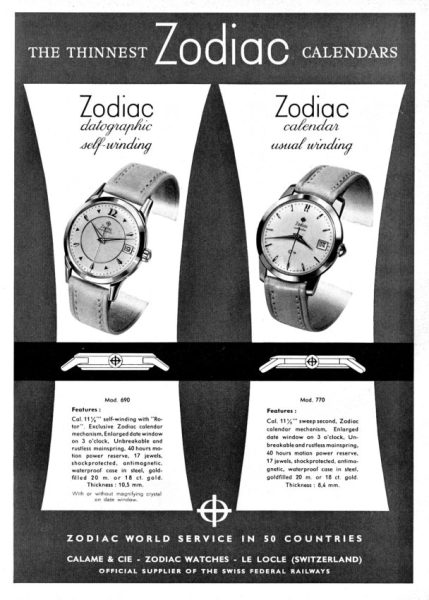
1955
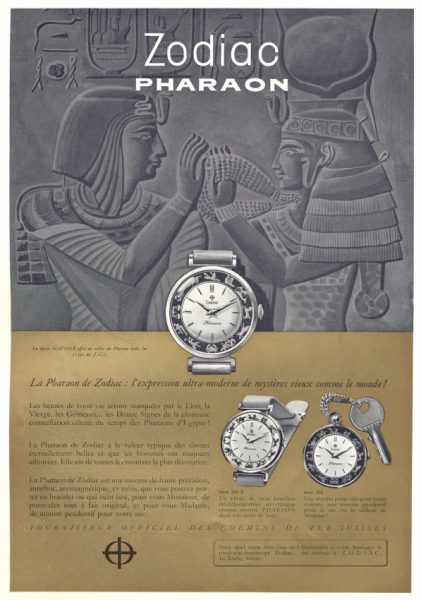
1957
While the Datographic model from 1955 is a classic automatic with date window, the Pharaon model from 1957 is not: this original watch features the twelve signs of the zodiac on the periphery of the dial.
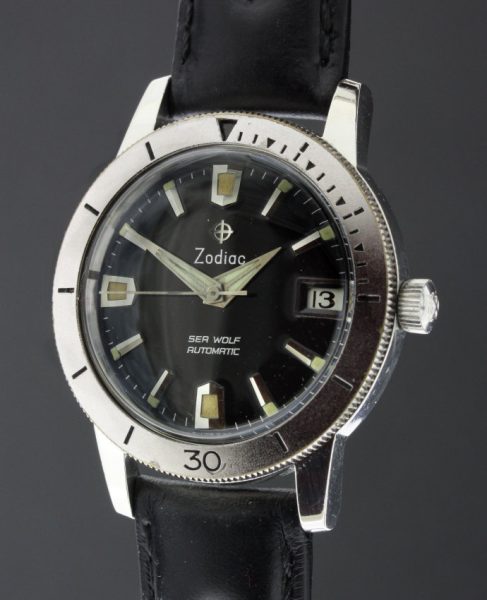
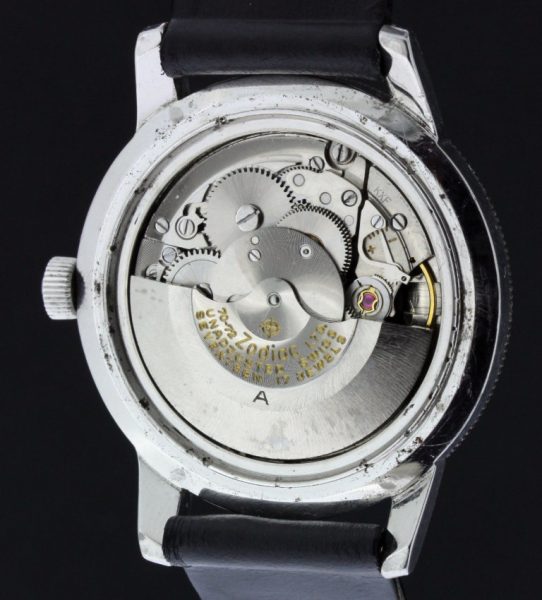
Automatic caliber with CHP fine adjustment
It was at the Basel Fair in 1958 that Zodiac presented its most famous watch to date: the Seawolf. It’s an automatic steel diver’s watch, with rotating bezel, water-resistant to 100 m. It was developed in collaboration with Cdt Cousteau’s laboratory38 . Several sources give 1953 as the year of birth of this model39 . This date is not innocent, since it coincides with the release of two iconic diving watches: the Rolex Submariner and the Blancpain Fifty Fathoms. But no reference is given to confirm this date. In fact, according to the company itself, design work began in 1955 and the first models were marketed in 195640 . The presentation at Basel in 1958 probably means that the watch underwent modifications before its official presentation, which is not surprising for a technical watch designed for professionals.
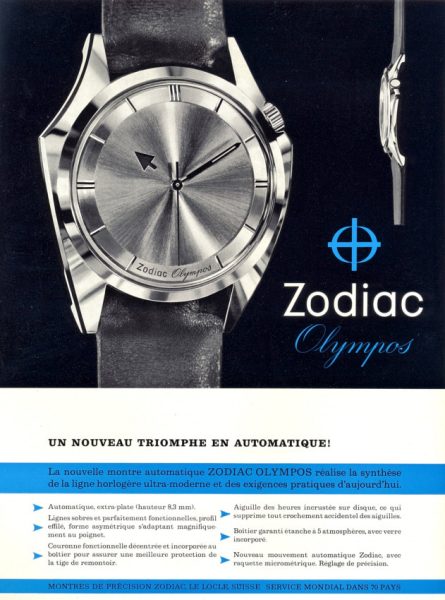
1960
In 1959, at the same time as the Seawolf’s water resistance was improved to 200 m, the asymmetrical New-Look model was launched, with a partially transparent hour hand. This model was renamed Olympos in 1960.
Around 1965, Zodiac watches also featured technical features that set them apart from other brands. They feature high-frequency movements (21,600 vph instead of 18,000), an original adjustment racket, and a stop-second system that is activated by pulling on the crown.
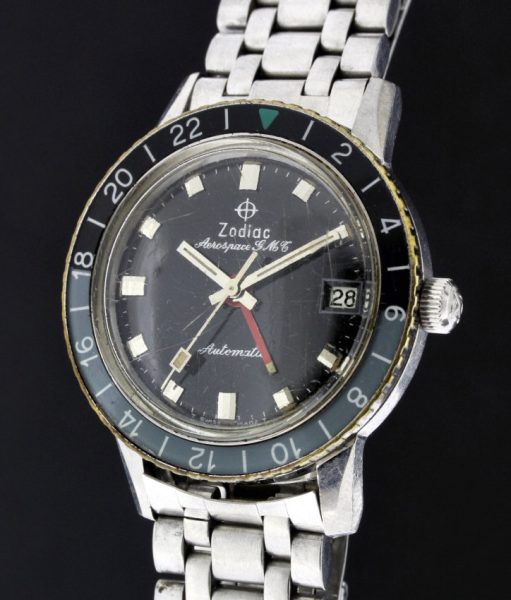
Aerospace GMT
In 1967, Zodiac adopted high frequencies thanks to its membership of CHP. This was the Kingline 36,000 line, later called the SST 36,000.
The same year sees the launch of the Aerospace GMT, with a hand and 24-hour rotating bezel for a second time zone.
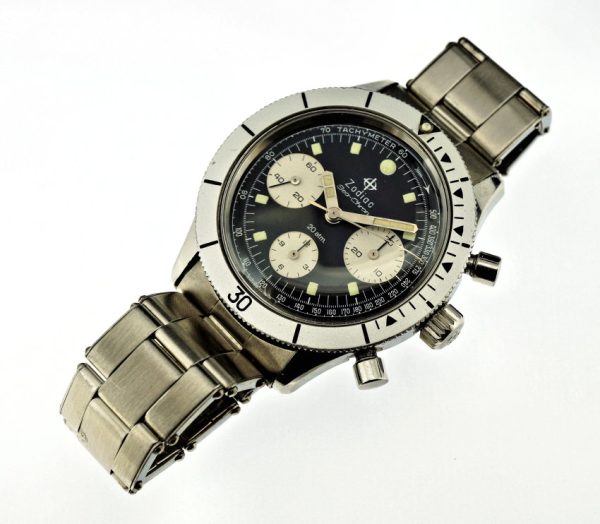
Sea-Chron chronograph
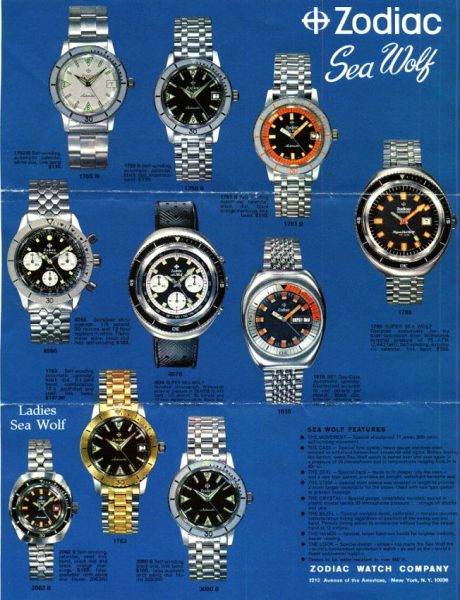
1968 was a banner year for Zodiac with the release of several remarkable models: the waterproof Sea-Chron chronograph, and above all the 750 m waterproof Super Seawolf and its 750 m waterproof Super Seawolf chronograph version!
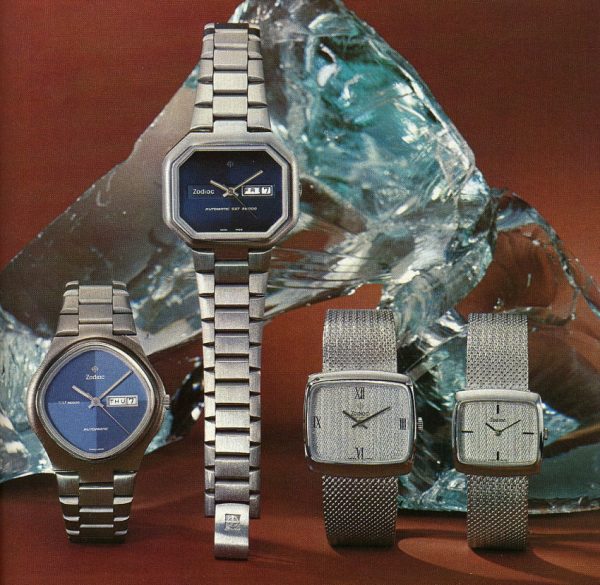
1975
In 1970 Zodiac introduced a new, original model: the Astrographic. The hands are printed on transparent discs, and a red dot for the seconds appears to float on the dial. This was to be Zodiac’s last original watch: quartz watches were to become fairly commonplace, despite commendable design work with an independent designer41 .
1 https://www.zodiacwatches.com/en-us/zodiac-legacy/
2 The Swiss Watch, 1957, 7, pp 31 ff
3 https://en.wikipedia.org/wiki/Zodiac_Watches#cite_note-6 consulted in February 2024
4 For example: https://expertswatches.com/pages/zodiac-swiss-1882-watches
5 The Swiss Watch, 1957, 7, p. 34
6 Revue Internationale d’Horlogerie, 1930, 18, p. 207
8 L’Impartial, April 13, 1972, p.17
9 La Fédération Horlogère, 1928, 8, p.1 – Accessible on Rero.doc
10 La Fédération Horlogère, 1928, 8, p.7 – Accessible on Rero.doc
11 Journal Suisse d’Horlogerie, 1957, 5-6, pp 190-194. Accessible on The Watch Library
13 Revue Internationale d’Horlogerie, 1930, 4, p. 37-39
14 La Fédération Horlogère, 1943, 39, p. 579. Available on Rero.doc
15 In the 1950s, this stop system was modified so that stopping was achieved by pulling on the crown rather than pushing.
16 Journal Suisse d’Horlogerie, 1957, 5-6, p. 192 – Accessible on The Watch Library
17 Patents CH 260 356 and CH 280 369
18 Journal Suisse d’Horlogerie, 1957, 5-6, p. 193 – Accessible on The Watch Library
19 Journal Suisse d’Horlogerie, 1951, pp 374 ff – Accessible on The Watch Library
20 FOSC 1945
21 La Suisse Horlogère, 1954, 4, p. I
22 L’Impartial, June 11, 1958, p.9. The composition of the CHP would later vary.
23 Journal Suisse d’Horlogerie, 1966, 5, p. 748 – Accessible on The Watch Library
24 La Suisse Horlogère, 1968, 1, pp 20-26
25 L’Impartial, May 15 1971, p.5
26 Interview with René Calame in La Suisse Horlogère, Weekly Edition, 1970, 23, p.861
27 Journal Suisse d’Horlogerie, 1972, 4, p.447 – Accessible on The Watch Library
28 L’Impartial November 20 1974, p.5
29 L’Impartial November 20, 1975, pp 1 and 3
30 L’Impartial December 11, 1975, pp 1 and 5. In fact, this technological lag was only relative, since many quartz watches were produced in Switzerland. But American electronics companies were able to lower their prices from month to month.
31 L’Impartial April 29, 1976, p. 15
32 L’Impartial August 7, 1978, p. 3
33 L’Impartial November 22 1978, p. 5
34 L’Impartial August 11, 1989, p.4
35 L’Impartial August 27, 1997, p.6
36 It will be placed in the center of the dial from 1952 onwards.
37 Journal Suisse d’Horlogerie, 1952, 1, p.39 – Accessible on The Watch Library
38 Journal Suisse d’Horlogerie, 1958, p. – Accessible on The Watch Library
39 For example: https://www.gearpatrol.com/watches/a679061/watches-you-should-know- 1953-zodiac-sea-wolf/ consulted in February 2024
40 Journal Suisse d’Horlogerie, 1964, 2, p.274 – Accessible on The Watch Library
41 L’Impartial, May 1er 1976, p.5
Thanks
Most of the watchmaking archives were consulted at the Musée International d’Horlogerie in La Chaux-de-Fonds, and I’d like to thank the museum’s curator, Régis Huguenin, and his team for their warm welcome.
The archives of the Fédération Horlogère, Le Davoine and L’Impartial are available online at www.doc.rero.ch
About Time To Tell: Time To Tell has one of the largest private digitized databases on the history of Swiss watchmaking, with over 2.3 TB of data on more than 1,000 Swiss watch manufacturers. This database has been built up over a period of some thirty years, and continues to be fed with around 50 to 100 GB of data every year. The database is made up of old documents, mostly Swiss trade magazines, dating from the late 19th to the late 20th century. Most of these documents are not available on the Internet. Historical articles published on time2tell.com always cite the sources used.
Time To Tell is a private company, independent of any watch manufacturer.
